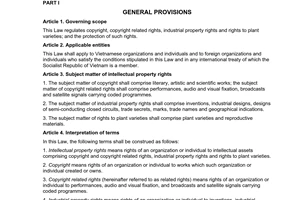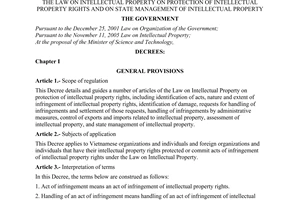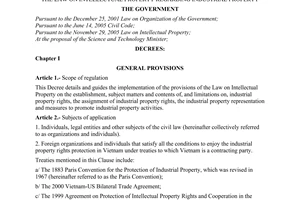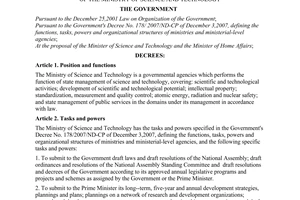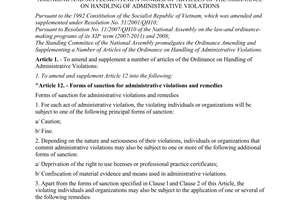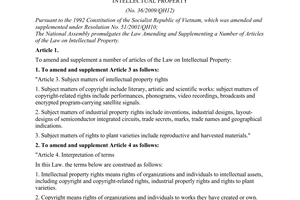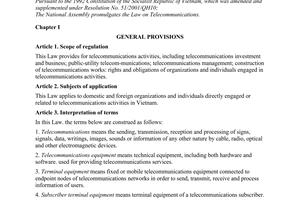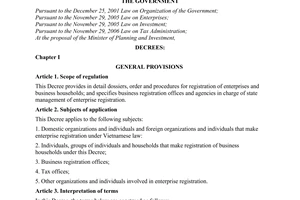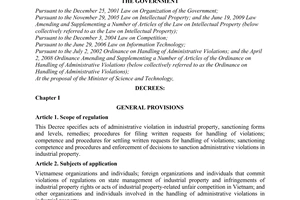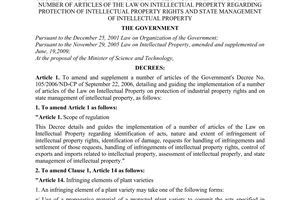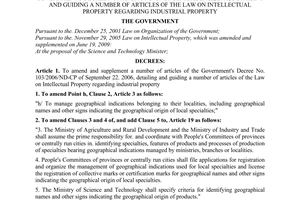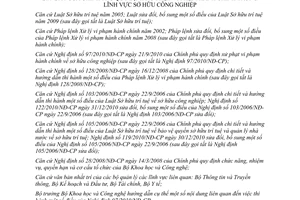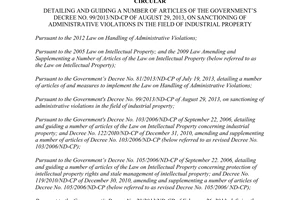Circular No. 37/2011/TT-BKHCN guiding the implementation of a number đã được thay thế bởi Circular No. 11/2015/TT-BKHCN detailing Decree no. 99/2013/ND-CP và được áp dụng kể từ ngày 11/08/2015.
Nội dung toàn văn Circular No. 37/2011/TT-BKHCN guiding the implementation of a number
|
THE
MINISTER OF SCIENCE AND TECHNOLOGY |
THE
SOCIALIST REPUBLIC OF VIETNAM |
|
No. 37/2011/TT-BKHCN |
Hanoi, December 27, 2011 |
CIRCULAR
GUIDING THE IMPLEMENTATION OF A NUMBER OF ARTICLES OF THE GOVERNMENT'S DECREE NO. 97/ 2010/ND-CP OF SEPTEMBER 21, 2010, ON SANCTIONING OF ADMINISTRATIVE VIOLATIONS IN INDUSTRIAL PROPERTY
Pursuant to the 2005 Law on Intellectual Property; and the 2009 Law Amending and Supplementing a Number of Articles of the Law on Intellectual Property Law (below collectively referred to as the Law on Intellectual Property);
Pursuant to the 2002 Ordinance on Handling of Administrative Violations; and the 2008 Ordinance Amending and Supplementing a Number of Articles of the Ordinance on Handling of Administrative Violations (below collectively referred to as the Ordinance on Handling of Administrative Violations);
Pursuant to the Government's Decree No. 97/2010/ND-CP of September 21, 2010, on sanctioning of administrative violations in industrial property (below referred to as Decree No. 97/2010/ND-CP);
Pursuant to the Government's Decree No. 128/2008/ND-CP of December 16. 2008, detailing and guiding the implementation of a number of articles of the Ordinance on Handling of Administrative Violations (below referred to as Decree No. 128/2008/ND-CP);
Pursuant to the Government's Decree No. 103/2006/ND-CP of September 22, 2006, detailing and guiding the implementation of a number of articles of the Law on Intellectual Property concerning industrial property; Decree No. 122/2010/ND-CP of December 31, 2010, amending and supplementing a number of articles of Decree No. 103/2006/ND-CP of September 22, 2006 (below referred to as amended Decree No. 103/2006/ND-CP);
Pursuant to the Government's Decree No. 105/2006/ND-CP of September 22, 2006. detailing and guiding the implementation of a number of articles of the Law on Intellectual Property concerning the protection of intellectual property rights and the state management of intellectual property; Decree No. 119/2010/ND-CP of December 30, 2010, amending and supplementing a number of articles of Decree No. 105/2006/ND-CP of September 22, 2006 (below referred to as amended Decree No. 105/2006/ND-CP);
Pursuant to the Government's Decree No. 28/2008/ND-CP of March 14, 2008, defining the functions, tasks, powers and organizational structure of the Ministry of Science and Technology;
Based on the written agreements of related line ministries: the Ministry of Information and Communications, the Ministry of Planning and Investment, the Ministry of Finance and the Ministry of Health;
The Minister of Science and Technology guides in detail a number of contents related to the implementation of a number of articles of Decree No. 97/2010/ND-CP,
Chapter I
GENERAL PROVISIONS
Article 1. Subjects and scope of application
1. Infringers defined in Article 2 of Decree No. 97/2010/ND-CP shall be administratively sanctioned when the following conditions are fully satisfied:
a/ They commit infringements specified in Chapter II of Decree No. 97/2010/ND-CP:
b/ Their infringements are subject to administrative sanctioning under Clause 1, Article 6 of the Ordinance on Handling of Administrative Violations:
c/ They commit infringements within the statute of limitations for sanctioning specified in Clauses 1, 2 and 3, Article 10 of the Ordinance on Handling of Administrative Violations.
2. Other related organizations and individuals defined in Article 2 of Decree No. 97/2010/ND-CP include:
a/ Organizations and individuals that file written requests for handling of administrative violations: organizations and individuals with related rights and interests in the course of handling administrative violations in industrial property;
b/ Agencies and officers competent to receive and settle written requests for handling of administrative violations, and examine, inspect and handle administrative violations in industrial properly;
c/ Agencies competent to perform the state management of industrial property; agencies competent to settle disputes over industrial property rights, complaints and denunciations about sanctioning of administrative violations in industrial property;
d/ Organizations and individuals that function to assess industrial property; organizations and individuals that provide industrial property representation services;
e/ The State Treasury, credit institutions and agencies with sanctioning competence that are responsible for collecting, remitting, deducting and transferring fines paid for and illegal profits gained from administrative violations; agencies, organizations and individuals that are responsible for executing and enforcing decisions on sanctioning of administrative violations in industrial property; agencies, organizations and individuals that manage business, advertising and printing activities or electronic information networks in which industrial property infringements occur;
f/ State management agencies in related sectors when receiving written conclusions or sanctioning decisions of agencies competent to handle violations in industrial property;
g/ Organizations and individuals that are responsible for or have related rights and interests in providing documents and evidence for verifying infringements and infringing goods or in implementing written conclusions or decisions on sanctioning administrative violations of agencies competent to handle industrial property infringements.
3. Written conclusions of agencies competent to handle administrative violations in industrial property arc construed as written conclusions on infringements and written notices of infringement handling results which are issued by these agencies on the basis of the agreements of involved parties.
A decision on sanctioning an administrative violation takes effect on the date of its signing, unless it indicates another effective date, in compliance with Clause 4. Article 56 of the Ordinance on Handling of Administrative Violations.
In case of a dispute or complaint about the validity of a protection title, a written conclusion of the state management agency in charge of intellectual property is construed as a decision to grant or refuse to grant a protection title or a decision to terminate or invalidate a protection title, which is issued by the National Office of Intellectual Property or the Ministry of Science and Technology and takes effect under law.
Article 2. Sanctions and remedies
1. Principal sanctions
a/ Caution shall be imposed under Point a, Clause 1, Article 3 of Decree No. 97/2010/ND-CP for an infringement involving one or several of the following circumstances:
(i) It is a first-time minor infringement which is understood to be a first-time industrial property infringement involving infringing goods of a quantity of up to 10 items and a value of under VND 3,000,000; and involving other extenuating circumstances specified in Clause 4, Article 3 of Decree No. 97/2010/ND-CP;
(ii) It is committed by a person who is between full 14 and under 16 years old.
b/ Fine shall be imposed for infringements not subject to caution and on the following principles:
(i) For infringements involving neither aggravating nor extenuating circumstances, the average level of the fine bracket shall be imposed.
(ii) For infringements involving one or several extenuating circumstances specified in Clause 4, Article 3 of Decree No. 97/2010/ND-CP a fine ranging from below the average level to the minimum level of the fine bracket shall be imposed. Some extenuating circumstances are guided as follows:
- Infringement committed by a person who does not know and has no condition to know about the status of protection of relevant industrial property rights referred to at Point b. Clause 4, Article 3 of Decree No. 97/2010/ND-CP is understood to be an infringement due. to deception or non-provision of information on the status of protection of relevant industrial property rights or caused by activities of another person which are unknown to the infringer.
- The infringer has prevented or mitigated harms of his/her infringement or has willingly remedied consequences and paid compensations for damage under Point a, Clause 1, Article 8 of the Ordinance on Handling of Administrative Violations, for example:
+ The infringer has stopped manufacturing or selling infringing goods at the request of the industrial property rights holder or a competent stale agency;
+ The infringer has willingly recalled infringing goods, made public corrections or apologies or paid compensations for damage caused to the industrial property rights holder.
(iii) For infringements involving one or several aggravating circumstances specified in Clause 4, Article 3 of Decree No. 97/2010/ND-CP a fine ranging from above the average level to the maximum level of the fine bracket shall be imposed. Some aggravating circumstances are guided as follows:
- Repetition of the infringement in the same field as specified in Clause 2, Article 9 of the Ordinance on Handling of Administrative Violations and Clause 2, Article 6 of Decree No. 128/2008/ND-CP is understood as follows:
+ Repeated commission of an industrial property infringement which has neither been detected nor sanctioned while the statute of limitations for sanctioning has not yet expired;
+ Repeated commission of the infringement after the involved parties have agreed on a measure to settle the case of infringement already acknowledged by a competent agency.
- Continued commission of the infringement despite a competent person's request to terminate such infringement under Clause 8, Article 9 of the Ordinance on Handling of Administrative Violations is understood to be the failure of the infringer to stop his/her infringement or lake measures to prevent or mitigate its harms, such as termination of the manufacture or sale of infringing goods at the request of an agency competent to handle the infringement.
2. Additional sanctions
a/ The sanction of confiscation and disposal of goods, material evidence and means used in the commission of the infringement subject to confiscation specified at Point a, Clause 2, Article 3 of Decree No. 97/2010/ND-CP shall be imposed according to the order and procedures specified in Article 37 of Decree No. 97/2010/ND-CP;
b/ The sanction of suspension for a definite period of lime of the trading or provision of infringing goods or services specified at Point c, Clause 2. Article 3 of Decree No. 97/2010/ ND-CP shall be imposed for the trading or provision of goods or services directly related to the infringement. The suspension shall be indicated in the administrative sanctioning decision.
3. Remedies
a/ Forcible removal of infringing elements specified at Point a. Clause 3. Article 3 of Decree No. 97/2010/ND-CP can be carried out by one or several methods, such as disassembly, cutting, erasure and grinding to remove infringing elements from goods, business transaction documents, signboards, packages, means of business or service provision or advertisement media, so that no infringing element can be found on goods and means that are material evidence of the infringement;
b/ Revocation of domain names or change of enterprise names containing infringing elements specified at Point a, Clause 3. Article 3 of Decree No. 97/2010/ND-CP shall be carried out as follows:
(i) Revocation of a domain name shall apply when the party requesting the infringement handling and the party against whom the infringement handling is requested fail to reach agreement under Clause 2, Article 29 of Decree No. 97/2010/ND-CP and the latter fails to stop holding the right to use or using the infringing domain name. The revocation of domain names shall be indicated in administrative sanctioning decisions. The agency competent to revoke domain names is the Vietnam Internet Network Information Center.
(ii) Forcible change of an enterprise name shall apply when the party against whom the infringement handling is requested fails to carry out procedures for changing the infringing enterprise name at the request of the business registry office or under a handling decision of the agency competent to handle industrial property infringements. Forcible change of enterprise names shall be indicated in administrative sanctioning decisions. Agencies competent to change enterprise names are business registry offices.
c/ Forcible re-export specified at Point c, Clause 3, Article 3 of Decree No. 97/2010/ND-CP shall apply to imports containing counterfeit industrial property objects and imported means, raw materials and materials used mainly for manufacturing or trading in these goods after infringing elements are removed from these goods.
Imported raw materials and materials used mainly for manufacturing or trading in goods containing counterfeit industrial property objects shall be identified under Clause 3, Article 29 of amended Decree No. 105/2006/ ND-CP.
Persons competent to apply the remedy of forcible re-export include chairpersons of provincial-level People's Committees, the director of the Anti-Smuggling Investigation Department, the director of the Post-Customs Clearance Inspection Department of the General Department of Customs, and directors of provincial-level Customs Departments.
d/ For infringing goods and raw materials, materials and means used for manufacturing these goods, and material evidence and means used for the commission of infringements which are not subject to destruction under Point d, Clause 3, Article 3 of Decree No. 97/2010/ND-CP competent agencies shall, based on the nature and characteristics of the goods and specific circumstances of the cases, decide on measures to handle the goods based on recommendations and opinions of rights holders, parties requesting the infringement handling and infringers.
Handling measures include permission for infringers to use these goods, raw materials and materials as raw materials for manufacturing other goods after the removal of infringing elements; permission for the finishing and putting of products into circulation under law after obtaining the consent of rights holders; permission for the auctioning of these goods, raw materials and materials to remit the proceeds therefore into the public fund, charities or social benefits with the consent of rights holders; or other measures requested and agreed upon by the involved parties in accordance with Clause 4, Article 29 of amended Decree No. 105/2006/ND-CP.
e/ In case infringing elements cannot be removed or the removal cannot effectively prevent infringements and other handling measures cannot be applied, competent agencies shall apply the remedy of forcible destruction under Clause 3, Article 36 of Decree No. 97/ 2010/ND-CP.
Expenses for the destruction of infringing elements, means and goods shall be paid by infringers. In case infringers are unable to conduct the destruction, agencies with sanctioning competence may use state budget funds specified in Article 14 of Decree No. 128/ 2008/ND-CP for the destruction. Infringers shall refund destruction expenses to agencies with sanctioning competence. Infringers that fail to refund destruction expenses shall be forced to do so.
f/ Remittance into the state budget of illicit earnings from the commission of administrative violations specified at Point h, Clause 3, Article 3 of Decree No. 9/2010/ND-CP shall apply when there are valid invoices, vouchers or documents evidencing that infringers have committed infringements (together with the quantity and value of infringing goods) though infringing goods have been sold out by the time of examination or inspection.
Remittance into the state budget of illicit earnings from the commission of administrative violations shall be indicated in administrative sanctioning decisions. Illicit earnings shall be remitted into the state budget according to the procedures similar to those for payment of fines under administrative sanctioning decisions. In case agencies with sanctioning competence have custody accounts opened at the State Treasury, such illicit earnings shall be remitted into these accounts. Periodically, agencies with sanctioning competence shall remit these amounts into the Slate Treasury under law.
Article 3. Determination of illicit earnings from the commission of administrative violations
1. Illicit earnings means sums of money earned from the commission of administrative violations in industrial property.
An illicit earning to be remitted into the state budget shall be determined according to the following formula:
Illicit earning = quantity of infringing goods sold or infringing services provided x profit.
- Quantity of infringing goods sold = quantity of infringing goods indicated in the vouchers or documents specified at Point a. Clause 2 of this Article - quantity of infringing goods unsold and detected at the time of examination or inspection.
The volume of infringing services provided shall be determined according to the above formula for determining the quantity of infringing goods sold.
- Profit = Price of goods sold or services provided - cost price or buying price.
2. Bases for determining illicit earnings
a/ Quantity of infringing goods or volume of infringing services, which is determined based on such vouchers and documents as accounting books, tax returns, purchase-sale contracts, financial invoices, sale invoices, books for monitoring sales: books for monitoring warehousing and ex-warehousing; import dossiers (for imports) or other documents of legal validity.
b/ Cost prices, buying prices, prices of goods sold or services provided:
(i) Cost prices shall be calculated based on accounting books, monitoring books, warehousing bills, ex-warehousing bills or other documents of legal validity of manufacturing establishments.
(ii) Buying prices shall be calculated based on goods purchase contracts and invoices, import declarations or written declarations to competent agencies or other relevant documents.
(iii) Prices of goods sold or services provided shall be calculated based on quoted prices, prices indicated in goods or service purchase and sale contracts, or prices indicated in sale invoices or written declarations to competent agencies or other relevant documents of legal validity.
c/ In case there is no information on quantity or prices on vouchers or documents or there is no voucher or document specified at Points a and b, Clause 2 of this Article, the quantity of infringing goods or volume of infringing services, cost prices, buying prices and prices of goods sold or services provided may be determined based on written reports or commitments of infringers. When necessary, competent agencies may apply measures to inspect, verify or collect evidence specified in Clauses 2. 3 and 6, Article 28 of Decree No. 97/2010/ND-CP.
Chapter II
VIOLATIONS TO BE ADMINISTRATIVELY SANCTIONED
Section 1: VIOLATIONS OF REGULATIONS ON MANAGEMENT OF INDUSTRIAL PROPERTY ACTIVITIES
Article 4. Violations of regulations on procedures for the establishment, exercise and protection of industrial property rights
Taking advantage of procedures for the establishment, exercise and protection of industrial property rights to infringe upon the State's interests, public interests or the rights and legitimate interests of other organizations and individuals referred to at Point b, Clause 1, Article 5 of Decree No. 97/2010/ND-CP is understood as:
1. Deliberately carrying out procedures for registration, requesting termination or invalidation or filing a complaint or a denunciation about procedures for the establishment, exercise and protection of industrial property rights without legal grounds, with a view to impeding production or business activities or the establishment, exercise and protection of industrial property rights of others.
2. Failing to carry out or deliberately carrying out in a dishonest or inadequate manner procedures for registration of industrial properly in Vietnam or overseas, disclosing confidential information of or depriving domestic organizations and individuals of opportunities to establish industrial property rights, thus harming the interests of the State, localities or enterprises.
Article 5. Violations of regulations on indications on protection of industrial property rights
1. Providing wrongful indications on the legal status referred to at Point b. Clause 1, Article 6 of Decree No. 97/2010/ND-CP is understood as using information misleading that entities have their industrial property rights protected in Vietnam though in reality they are ineligible for or have not yet obtained the protection, even in case they have filed registration applications but not yet been granted protection titles or have their protection titles cancelled or invalidated or the protection duration has expired, for example:
a/ Printing on goods, goods packages or means of service such indications misleading that these products or services bear a protected mark as "mark registered for exclusive protection", "protected mark", "mark exclusively owned by...", including the use of the symbol ® (the indication that a mark has been granted a mark registration certificate);
b/ Printing on products or product packages such indications misleading that these products enjoy such industrial design or patent protection as "product under industrial design protection", "product under patent protection", "product manufactured from a patented process of...", including the use of the word "P" or "Patent" with numbers (the indication that a product is patented).
2. Providing wrongful indications on the scope of protection of industrial property rights referred to at Point b. Clause 1, Article 6 of Decree No. 97/2010/ND-CP is understood as misleading about the scope of protection of industrial property rights to products, goods or services outside the protection scope of their titles.
3. Providing wrongful indications or no indication on goods manufactured under licensing contracts referred to at Point c, Clause 1, Article 6 of Decree No. 97/2010/ND-CP is understood as follows:
a/ Providing wrongful indications is inscribing on products the phrase "manufactured under licensing contract of or providing similar indications, whether in Vietnamese or a foreign language, though in reality the industrial property objects have not yet been licensed under law.
b/ Failing to provide indications is failing to inscribe on products or means of service relevant licensing indications if these products or services arc manufactured or provided under licensing contracts and the inscription of such indications is mandatory under law.
Article 6. Violations of regulations on industrial property representation
1. Concurrently representing parties to a dispute over industrial property rights referred to at Point a. Clause 2, Article 7 of Decree No.97/2010/ND-CP is understood as follows:
a/ Performing the authorized representation for both the party requesting the handling of the industrial property infringement and the party against whom the infringement handling is requested in the same case;
b/ Acting as the representative for the party carrying out procedures for objection, request for cancellation or invalidation of the protection title or infringement handling while acting as the representative for the protection title applicant or holder in carrying out procedures for the establishment, exercise and protection of industrial property rights.
2. Deliberately obstructing the normal progress of the establishment, exercise and protection of industrial property rights, causing damage to parties with related rights and interests referred to at Point i, Clause 2, Article 7 of Decree No. 97/2010/ND-CP is understood as follows:
a/ Deliberately delaying the filing of an industrial property registration application, written infringement handling request and other documents and dossiers in the course of establishment, exercise and protection of industrial property rights of the represented party without plausible reasons;
b/ Providing inaccurate information on the legal status of the protection title, industrial property registration application, written infringement handling request and other documents and dossiers in the course of establishment, exercise and protection of industrial property rights, affecting the rights and legitimate interests of the protection title holder;
c/ Filing a groundless complaint about the grant of or refusal to grant a protection title in order to delay the settlement process of competent agencies, causing material or spiritual damage to persons with related rights and interests.
3. Industrial property representatives that commit serious errors or violations in the course of practicing representation, causing damage to the interests of the State or the society referred to at Point b, Clause 4, Article 7 of Decree No. 97/2010/ND-CP is understood as follows:
a/ Representing organizations or individuals that are not rights holders or without permission of registered rights holders of well-known and widely used marks or organizations or individuals not empowered to manage geographical indications or register Vietnamese geographical indications overseas; registering confidential inventions overseas without permission of competent agencies;
b/ Disclosing information or documents not yet allowed to be published, information classified as state secret or business secret of related parties which is acquired in the course of providing industrial property representation services.
Article 7. Violations of regulations on industrial property assessment
1. Disclosing secret information acquired in the course of conducting assessment without permission of related parties referred to at Point b, Clause 2, Article 8 of Decree No. 97/2010/ND-CP is understood as follows:
a/ Disclosing secret information or documents related to cases being settled which is/are provided by agencies competent to solicit industrial property assessment or industrial property assessment requesters;
b/ Disclosing information or documents not yet allowed to be published, information classified as state secret or business secret provided by competent agencies or assessment requesters for assessment purposes.
2. Taking advantage of the assessor status and assessment activities for self-seeking purposes referred to at Point a. Clause 3, Article 8 of Decree No. 97/2010/ND-CP is understood as taking advantage of the status of assessing organizations or assessors or the participation in assessment activities to exert influence on related parties for seeking illicit profits.
3. Deliberately making untruthful assessment conclusions referred to at Point b. Clause 3, Article 8 of Decree No. 97/2010/ND-CP is understood as deliberately making unfair assessment conclusions untrue to information and documents provided for the assessment.
Section 2: INFRINGEMENTS OF INDUSTRIAL PROPERTY RIGHTS
Article 8. Infringements of industrial property rights referred to in Articles 10, 11 and 12 of Decree No. 97/2010/ND-CP
1. An act shall be concluded as an infringement of industrial properly rights specified in Articles 10, 11 and 12 of Decree No. 97/2010/ND-CP when fully satisfying the conditions specified in Article 5 of amended Decree No. 105/2006/ND-CP.
2. Evidence of the status of industrial property rights holders and their right to request infringement handling shall be determined under Article 24 of amended Decree No. 105/ 2006/ND-CP and Article 24 of Decree No. 97/ 2010/ND-CP Evidence of the status of industrial property rights holders is further guided as follows:
a/ Evidence of the status of the owner of a trade name is documentary or material evidence proving the first and lawful use of this trade name in the business sector satisfying the protection conditions specified in Articles 76, 77 and 78 of the Law on Intellectual Property;
b/ Evidence of the status of the owner of a business secret is documents proving that an organization or individual lawfully holds and has applied measures to keep confidential information classified as a business secret under Articles 84 and 85 of the Law on Intellectual Property;
c/ An industrial property licensing contract which has not yet been registered with the National Office of Intellectual Property but has contents compliant with the provisions of Articles 141 thru 144 of the Law on Intellectual Properly can serve as a valid documentary evidence of the lawful right to use the licensed industrial property object;
d/ In case an industrial properly licensing contract, mark utilization rules or geographical indication utilization license has no agreement or regulation restricting the licensee's right to request infringement handling, such licensee may request infringement handling under Decree No. 97/2010/ND-CP on the condition that the rights holder makes no written objection to such request.
In addition to documents and evidence proving the status of rights holders specified in Article 24 of amended Decree No. 105/2006/ ND-CP, rights holders may submit copies of documentary evidence of their status and produce their originals for comparison.
3. The identification of the protection scope of industrial property rights to serve the identification of an infringement of industrial property rights complies with Article 16 of amended Decree No. 103/2006/ND-CP and Article 6 of amended Decree No. 105/2006/ ND-CP.
The identification of elements infringing upon industrial property rights complies with Articles 8, 9, 10, 11, 12 and 13 of amended Decree No. 105/2006/ND-CP.
4. Notes be taken when identifying elements infringing upon rights to inventions:
a/ A product/product part/process in question shall be considered identical or similar to a patented product/product part/process defined at a certain point (independent or dependent) of the protection claim of an invention patent/ utility solution patent if all substantial technical specifications (features) stated at that point are present in the product/product part/process in question in an identical or similar form, of which:
(i) Two technical specifications (features) are considered identical if they are of the same nature or for the same utility or have the same obtaining method and the same relationship with other specifications defined in the protection claim;
(ii) Two technical specifications (features) are considered similar if they are of similar natures or interchangeable, and have substantially similar utilities and obtaining methods.
b/ If a product/product part/process in question does not contain at least one substantial technical specification (feature) defined at a certain point of the protection claim, such product/product part/process shall be considered not identical/similar to the patented product/product part/process under that point.
5. Notes to be taken when identifying elements infringing upon rights to industrial designs:
a/ A product/product part in question is regarded as a copy of a patented industrial design if such product/product part has a combination of visual design features (shape) incorporating all fundamental design features of the patented industrial design;
b/ A product/product part in question is regarded as a substantive copy of a patented industrial design if such product/product part has a combination of visual design features incorporating almost all fundamental design features of the patented industrial design and is distinctive only in design features which are not easy to recognize or memorize:
c/ In case the composition of visual design features of a product/product part is regarded as a copy or substantive copy of the combination of visual design features of at least one product in a set of products having a patented industrial design, such shall also be regarded as an infringement of rights to the patented industrial design;
d/ Fundamental design features of a patented industrial design are understood as easily recognizable and memorable design features which are used for distinguishing one industrial design in whole from another. The combination of fundamental design features may be three-dimensional configuration, lines, correlation between three-dimensional and/or lineal features, and colors identified on the basis of photos/drawings or the description of the industrial design attached to the industrial property patent.
6. Notes to be taken when identifying elements infringing upon rights to marks:
a/ Grounds for assessing the confusability of a sign with a protected mark include:
(i) The protection scope of the mark in whole or in part; similarity of the sign to the protected mark in whole and to its distinguishable parts, especially those which are highly impressive to consumers;
(ii) Relevance of goods or services in functions, utilities and ingredients: practices of trading, distribution, selection and use of goods and services; conditions, methods and places for goods or service sale, distribution, marketing, promotion or trading;
(iii) Characteristics of goods or service consumers; level of attention of consumers when selecting or purchasing goods or services;
(iv) Other criteria such as practical use and protection of similar marks for the same goods; impacts of other elements which indicate the relationship of goods or services in question with protected goods or services;
(v) Evidence of confusion consequences on consumers which can be used to support the assessment of the confusabilitv of the use of the sign though it is not mandatory in making conclusions on the confusabilitv of the use of the sign.
b/ Notes to be taken when identifying infringements of rights to marks:
(i) In case of using a sign for goods or services identical to a mark and goods or services identified in a mark registration certificate or an international registration certificate of a mark protected in Vietnam or in the W1PO Official Gazette of International Marks, it is unnecessary to assess the possibility of such sign to confuse consumers about goods and services bearing the mark;
(ii) In case of using a sign identical to a mark for similar or relevant goods or services; using a sign similar to a mark for goods or services identical or similar or relevant to goods or services on the list of goods or services bearing the mark identified in a mark registration certificate or an international registration certificate of a mark protected in Vietnam or in the WIPO Official Gazette of International Marks, it is necessary to assess the possibility of such sign to confuse consumers about goods and services bearing the mark.
c/ Notes to be taken when identifying infringements of rights to well-known marks:
(i) In case of using a sign identical or similar to a well-known mark or a sign interpreted or transcribed from a well-known mark for any goods or services, including those which are neither identical, similar nor relevant to goods or services on the list of goods and services bearing well-known marks, it is necessary to assess the possibility of such sign to mislead as to the origin of goods or services or the relationship between the sign user and the well-known mark owner;
(ii) If the use of a sign identical or similar to a well-known mark specified in Item (i), Point c, Clause 6 of this Article is not likely to mislead as to the origin of goods or services but gives a false impression on consumers of the relationship between the sign user and the well-known mark owner, such use is also regarded as infringement of industrial property rights;
(iii) Upon filing a written request for handling of an infringement of rights to a well-known mark, a rights holder shall provide evidence showing that such mark is already well-known in Vietnam according to the criteria specified in Article 75 of the Law on Intellectual Property, regardless of whether has been registered for protection in Vietnam;
(iv) Before deciding to carry out procedures for infringement handling, an agency competent to handle infringements shall base itself on the criteria specified in Article 75 of the Law on Intellectual Property to consider whether a mark is well-known in Vietnam. This agency may exchange expertise opinions with the National Office of Intellectual Property and consult an advisory council.
In case a well-known mark is recognized in Vietnam according to civil procedures or under a recognition decision of the National Office of Intellectual Property, the infringement-handling agency may base itself on relevant documents to consider recognizing such mark as well-known in Vietnam, provided such agency's recognition of the well-known mark is still appropriate at the time of requesting infringement handling.
7. Notes to be taken when identifying elements infringing upon rights to trade names:
a/ The ground for examining elements infringing upon rights to a trade name is the protection scope of such trade name identified on the basis of evidence of the lawful use of such trade name, identifying the business entity, business establishment, business activities and products or services bearing the trade name, specifically as follows:
(i) Evidence showing that the trade name is used in the business place (for example: it is used in the locality in which customers or business partners are based or in which it earns its reputation through advertising, marketing or distribution) in a lawful business sector (staled in the business registration certificate, investment license, business eligibility certificate for conditional business lines, tax identification number registration or company charter already registered with a competent agency or other papers of legal validity);
(ii) The time of starling the use and the process of use: The trade name has been and is known to business partners and customers through goods, services or business activities (for example: it is currently used on goods, sale-purchase contracts, goods orders, business transaction documents, advertisement materials, customs declarations, tax receipts and other transaction documents).
b/ The business registration certificate, investment license, business eligibility certificate for conditional business lines, tax identification number registration or company charter is regarded as evidence of the lawfulness of business activities conducted under the trade name. The enterprise name staled in the above certificate or license may be regarded as a trade name only when there is documentary evidence showing that it is actually used in lawful business activities and satisfies the protection conditions specified in Articles 76, 77 and 78 of the Law on Intellectual Property.
c/ In case the use of a mark, industrial design, copyright, trade name or geographical indication leads to a conflict and gives rise to a dispute, the settlement of such conflict and dispute complies with Article 6 of the Law on Intellectual Property. Article 17 of amended Decree No. 103/2006/ND-CP Article 29 of Decree No. 97/2010/ND-CP and the following specific guidance:
(i) Based on documents and evidence proving the time of arising or establishment of rights on the principle that rights to a certain object arising or established earlier will be protected.
In case all involved parties have evidence proving that their rights arise or are established lawfully, they may exercise their rights within the scope and term of protection without infringing upon the State's interests, public interests, rights and legitimate interests of other institutions and individuals, and may not violate other relevant laws;
(ii) Based on the protection title, certificate or certification of a competent agency and relevant documents, contents of lawful contracts or agreements between the parties to identify the protection scope of an object which is protectable concurrently as different intellectual property objects;
(iii) In case a trade name or mark bearing a geographical name is used before the relevant geographical indication or mark bearing the geographical name is granted a protection title and these objects all satisfy the protection conditions specified by law, the bona fide use of such object is not regarded as an infringement under Point g or h, Clause 2, Article 125 of the Law on Intellectual Property.
d/ In case the concurrent use of the objects specified at Point c of this Clause affects the rights and interests of a third party, consumers and the society and there is an infringement handling request, the agency competent to handle infringements shall request the involved parties to reach agreement on and record in writing the conditions for and method of using of these objects according to the procedures specified in Clause 2, Article 29 of Decree No. 97/2010/ND-CP The party that continues such use which is regarded as an infringement of industrial property rights of another party and does not enter into the agreement or fails to strictly implement the recorded agreement shall be sanctioned under Decree No. 97/2010/ND-CP.
8. Notes to be taken when identifying infringements of rights to geographical indications:
a/ Grounds for assessing the confusability of a sign with a geographical indication may be applied appropriately like those for assessing the confusability of a sign with a protected mark.
b/ Infringing products or goods may be:
(i) A product of the same type bearing a sign identical to a protected geographical indication and manufactured in a location in the area subject to the protected geographical indication but not satisfying the condition of special quality bearing such geographical indication;
(ii) A product of the same type bearing a sign identical or similar to a protected geographical indication but not manufactured in a location in the area subject to the protected geographical indication, even if such product has corresponding parameters of quality, manufacturing process and product management;
(iii) A product of the same type bearing a sign identical or similar to a protected geographical indication, manufactured in a location in the area subject to the protected geographical indication and satisfying the special quality conditions, but its manufacturer is not licensed by the institution managing such geographical indication;
(iv) A similar product bearing a sign identical or similar to a protected geographical indication in order to take advantage of the well-known status and reputation of the geographical indication and/or misleading as to the geographical origin of the product, regardless of whether the manufacturing location of such product is in the area subject to the protected geographical indication.
9. Notes to be taken when identifying infringements of industrial property rights referred to in Clause 11, Article 11; Clause 10.Article 12; and Clause 7, Article 14 of Decree No. 97/2010/ND-CP:
a/ In case an organization or individual affixes an infringing sign on products or goods in the manufacturing process, a competent agency shall handle the infringer for the manufacturing act.
b/ In case an organization or individual does not carry out manufacturing activities but only affixes an infringing sign on products or goods or their packages, a competent agency shall handle the infringer for the act of affixing the infringing sign.
10. Notes to be taken when handling infringements of industrial property rights in exportation or transit:
A competent agency shall handle an infringement in the exportation or transit of infringing goods in case it has evidence that the declaration of exported or transited goods is untrue for the purpose of putting such goods into circulation in Vietnam.
11. The reuse, repair or recycling by an organization or individual of a product or product package bearing a mark, trade name or geographical indication already marketed by the rights holder to create another product is also regarded as an infringement of industrial properly rights or an act of unfair competition if such reuse, repair or recycling misleads consumers as to the commercial origin of the product, business entity, business activities or properties of the product as defined in relevant regulations on infringement of industrial property rights and unfair competition.
The provisions of this Clause do not apply in case products bear an explicit notification that they or their packages are reused, repaired or recycled and all signs likely to mislead consumers as to the commercial origin of products, business entities, business activities or properties of products as defined in relevant regulations on infringement of industrial property rights and unfair competition have been removed.
Article 9. Infringements referred to in Article 13 of Decree No. 97/2010/ND-CP
1. Infringements referred to in Article 13 of Decree No. 97/2010/ND-CP include cases in which organizations or individuals detect stamps, labels or articles bearing counterfeit marks or geographical indications which have not yet been affixed on products but there are sufficient grounds to believe that such stamps, labels or articles are to be affixed on products to be marketed (for example, under trading contracts, printing contracts, written declarations to competent agencies, or specimen packages or products affixed with infringing stamps, labels or articles which arc currently stored, transported or displayed for sale).
2. Other stamps, labels or articles referred to in Article 13 of Decree No. 97/2010/ND-CP are understood as stamps of various kinds of manufacturers, distributors or importers to be affixed on products, including quality control stamps; goods labels; decals; product packages; detachable product parts which cannot be independently circulated, on which counterfeit marks or geographical indications are printed, cast or embossed.
Article 10. Parallel importing
1. Parallel importing referred to in Clause 2, Article 28 of Decree No. 97/2010/ND-CP means importation by organizations or individuals of products already marketed overseas by their owners or licensed organizations or individuals, including licensees under compulsory licensing decisions, or persons with prior right to use industrial property objects, without the permission of industrial property rights holders.
2. Organizations and individuals that carry out parallel importing are not administratively sanctioned. Below arc some examples of parallel importing:
a/ Company A is the owner of an invention patent for product X currently under protection in Vietnam. Company A authorizes its agent being company B based in Vietnam to exclusively import and distribute product X in Vietnam. Company C purchases and imports into Vietnam product X manufactured and sold by company A in an overseas market without the permission of companies A and B;
b/ Company A is the owner of the patent for industrial design Y currently protected for product G in Vietnam. Company A licenses company B to manufacture product G bearing industrial design Y in Vietnam, and concurrently licenses company C to manufacture product G bearing industrial design Y in another country. Company D purchases and imports into Vietnam product G bearing industrial design Y manufactured and sold by company C in an overseas market without the permission of companies A, B and C;
c/ Company A is the owner of mark Z protected for product T in a foreign country. Company A establishes a branch being company B in Vietnam and permits company B to file a registration application for and hold a registration certificate of mark Z for product T in Vietnam. Company C purchases and imports into Vietnam product T bearing mark Z manufactured and sold by company A in an overseas market without the permission of companies A and B.
Article 11. Unfair competition in the field of industrial properly referred to in Article 14 of Decree No. 97/2010/ND-CP
1. Using misleading trade indications
a/ Entitled to request the handling of the act of using misleading trade indications are business entities that have earlier used trade indications stipulated in Clause 2, Article 130 of the Law on Intellectual Property extensively and stably in their lawful business activities in Vietnam, and have their reputation and goods and services bearing those trade indications known to consumers:
b/ Trade indications stipulated in Clause 2, Article 130 of the Law on Intellectual Property include industrial property objects (mark, trade name and geographical indication) and the following objects:
(i) "Goods label" which is a handwritten or printed script, drawing or photo of words, graphics or images directly stuck, printed, attached to, cast, carved or engraved on goods or commercial packages of goods or on other materials affixed on goods or commercial packages of goods, showing fundamental and necessary information on goods to help consumers recognize, choose, consume and use these goods, manufacturers and traders advertise their goods, and functional agencies conduct inspection and control;
(ii) "Business slogan" which is a phrase appearing beside an enterprise name or a mark of an enterprise's product to emphasize the enterprise's business goal or principle or customers targeted by the product.
For example: Bitis': "Nang niu ban chan Viet" (Bitis': "Cosset Vietnamese feet"), or
Ca phe Trung Nguyen: "Khoi nguon sang tao" (Trung Nguyen coffee: "Source of creative inspiration");
(iii) "Business logo" which is a sign, word, graphic or three-dimensional figure uniquely designed and used as an enterprise's symbol in its business activities;
(iv) "Goods package design" which is a design or pattern of goods packages, consisting of shapes, lines, graphics, words, numbers, colors, presentation, color mix, layout or a combination of these elements to create a particular impression or feature of goods packages.
c/ Misleading trade indication is a trade indication containing signs (constituents, presentation, combination of elements, colors and general impression on consumers) identical or confusingly similar to a corresponding trade indication of the rights holder requesting the handling of an unfair competition act which is used for identical or similar goods or services.
The use of such an indication aims to mislead consumers as to the business entity or activities or the commercial origin of goods or services, geographical origin, manufacturing method, properties, quality, quantity or other characteristics of goods or services, or goods or service provision conditions.
d/ An entity requesting the handling of unfair competition in using a misleading trade indication shall provide evidence to prove that:
(i) A business entity has used this trade indication widely and stably and is therefore known to many consumers in Vietnam, with such evidence as information on advertisement, marketing, display and exhibition; sales; quantity of sold products; system of distribution agents, joint ventures and partners; investment scale; evaluations of state agencies and the mass media, consumer picks and other information showing the reputation of the business entity associated with the trade indication in its business activities in Vietnam;
(ii) The party requested to be handled has used the misleading trade indication on goods, goods packages and means of business, service or advertisement;
(iii) The party requested to be handled continues to use the misleading trade indication despite having been requested by the rights holder to terminate such use or to change the indication.
2. Registering for holding the right to use or using domain names
a/ Entities that may request the handling of the act of registering for holding the right to use or using domain names are owners of marks, geographical indications or trade names that have used these objects widely and stably in their lawful business activities in Vietnam and have their well-known status and reputation as industrial property rights holders and their goods or services bearing those marks, geographical indications or trade names known to consumers in relevant sectors.
b/ Registering for holding the right to use or using domain names is regarded as an act of unfair competition in industrial property in Vietnam, except for domain names already allocated through auction or competitive examination under Point a, Clause 2, Article 48 of the Law on Telecommunications, in any of the following cases:
(i) Using Vietnam's national domain name ".vn" with wordings identical or confusingly similar to a mark, trade name or geographical indication currently protected and used for advertisement or introduction of products, offer for sale or sale of identical, similar or relevant goods or services on the website addressed by such domain name; causing confusion and harm to the reputation or material interests of the owner of such mark, trade name or geographical indication:
(ii) Registering for holding the right to use Vietnam's national domain name ".vn" with wordings identical or confusingly similar to a mark, trade name or geographical indication well-known or reputable in Vietnam but such domain name has not yet been used for any specific activities for more than one year and there is a ground to believe that the registration for holding the right to use such domain name is made only for resale for profits or to prevent the owner of such protected mark, trade name or geographical indication from registering the domain name.
c/ Entities requesting the handling of the act of registering for holding the right to use or using domain names which is regarded as an act of unfair competition in industrial property shall provide evidence to prove that:
(i) The rights holder has used a mark, geographical indication or trade name in a widespread and stable manner and has its well-known status and reputation as an industrial property rights holder and its goods or services bearing such mark, geographical indication or trade name known to consumers in Vietnam (possibly information on advertisement, marketing, display and exhibition; sales; quantity of products sold; system of distribution agents, joint ventures and associations; investment scale; evaluations of state agencies and the mass media, consumer picks and other information showing the well-known status and reputation of the business entity, goods or services bearing such mark, geographical indication or trade name) in its business activities in Vietnam;
(ii) The party requested to be handled has used the domain name on the Internet for advertisement or introduction of products, offer for sale or sale of identical, similar or relevant goods or services, causing harm to the reputation or material interests of the owner of the protected mark, trade name or geographical indication.
The party requested to be handled continues to use a misleading mark, trade name or geographical indication through such domain name despite having been notified and offered by the owner of such mark, trade name or geographical indication to reach agreement on reasonable conditions for such use, to which it does not consent;
(iii) The party requested to be handled has registered but failed to activate within one year the domain name with wordings identical to a mark, trade name or geographical indication which is in widespread use and well known and reputable in Vietnam and there is a ground to believe that this party has registered for holding the right to use the domain name only for resale for profits or to prevent the owner of such protected mark, trade name or geographical indication from registering the domain name, despite having been notified and offered by the industrial property rights holder to reach agreement on reasonable conditions for such use, to which it does not consent;
(iv) The party requested to be handled has no rights and legitimate interests related to the protected mark, geographical indication or trade name of the rights holder.
Chapter III
PROCEDURES FOR FILING REQUESTS AND HANDLING INFRINGEMENTS
Article 12. Infringement handling requests and accompanying evidence
1. Infringement handling requests must satisfy the conditions specified in Article 26 of Decree No. 97/2010/ND-CP.
2. Documents and evidence accompanying requests:
a/ Copies of certificates, protection titles and other documents arc considered valid if rights holders produce their originals for comparison or these copies are certified by competent agencies or agencies granting their originals. Dossier-receiving officers shall sign for certification in copies already compared with their originals for which certification of public notary offices or agencies having granted such certificates or titles is not required.
b/ Reports of rights holders (on turnover, reputation, advertisement, widely used evidence, copies of certificates and protection titles in other countries) to infringement-handling agencies are considered valid if these rights holders make commitments to taking legal responsibility for the contents and information of their reports and the reports bear their or their lawful representatives' signatures and seals (if any). For a multi-paper port, the right holder shall initial every page or append a seal (if any) on every two adjoining pages.
This provision also applies to documents provided by parties requested to be handled.
Article 13. Filing of infringement handling requests
1. In an infringement handling request, the rights holder may request the handling of:
a/ One or more than one infringement against one or more than one industrial property object committed by the same organization or individual;
b/ One or more than one infringement against one industrial property object committed by more than one organization or individual;
c/ In case of requesting the handling of one or more than one organization or individual committing infringements in the same locality, the rights holder is required to file only one request with the competent agency in such locality:
d/ In case of requesting the handling of one or more than one organization or individual committing infringements in different localities, the right holder may file a request with the competent agency in each locality or with a central agency competent to handle infringements in these localities.
2. In case different agencies are competent to handle an infringement, the rights holder may choose one of them to file a handling request.
For example: The Inspectorate of the Ministry of Science and Technology, the Inspectorate of the Ministry of Information and Communications and the Vietnam Competition Authority are all competent to handle acts of unfair competition related to domain names. Rights holders may choose one of these agencies to file requests for administrative handling of acts of unfair competition related to domain names according to the order and procedures specified in Decree No. 97/2010/ND-CP.
3. In case a rights holder concurrently files a request with many competent agencies for handling of the same infringement, the agency that accepts the request first shall handle the infringement.
a/ Before accepting a case, if the request-receiving agency knows that another competent agency or a court has accepted this case, it shall notify its refusal to accept the request.
b/ After accepting a case and before inspecting, examining and handling an infringement, if the request-receiving agency knows that another competent agency has inspected, examined and handled the infringement or a court is handling the case, it shall notify its refusal to carry out infringement handling procedures.
c/ After conducting inspection and examination, if the infringement-handling agency knows that another agency has conducted inspection and examination, it shall request the latter to coordinate with it in the handling and agree to let either of them carry out sanctioning procedures. In case another agency has handled the infringement but the infringement-handling agency detects that an organization or individual is still committing this infringement at the time of inspection and examination, it shall handle the infringement with the aggravating circumstance of recidivism.
d/ In the course of infringement handling, if detecting signs of a crime, the infringement-handling agency shall transfer the case dossier to a competent investigative agency in the locality in which the infringement is committed.
Article 14. Authorized infringement handling request
Powers of attorney for filing of infringement handling requests enclosed with these requests must satisfy the conditions specified in Article 25 of Decree No. 97/2010/ND-CP with attention paid to the following cases:
1. In case an original power of attorney containing the authorization for carrying out procedures for infringement handling and industrial property rights protection and enforcement has been enclosed with the dossier previously filed with the same infringement-handling agency, the rights holder shall submit a copy and indicate where the original power of attorney is filed.
2. In case an original power of attorney containing the authorization for carrying out procedures for infringement handling and industrial property rights protection and enforcement has been submitted to the National Office of Intellectual Property or another competent agency, the rights holder shall submit a copy certified by the agency keeping the original power of attorney.
Article 15. Examination of infringement handling requests
1. In case an infringement handling request provides sufficient evidence of goods bearing a counterfeit industrial property object or infringing upon rights to a mark, geographical indication or industrial design, a competent agency shall coordinate with the rights holder in inspecting, examining and handling the infringement under Point d. Clause 2, Article 27 of Decree No. 97/2010/ND-CP.
2. In case an infringement handling request provides insufficient evidence of goods bearing a counterfeit industrial property object or infringing upon rights to a mark, geographical indication or industrial design: or for a request for handling an infringement against an invention, layout design, trade name or business secret; or a request for handling an act of unfair competition in industrial property, a competent agency may request the involved parties to provide information and evidence and give explanations within 10 days after the date fixed in the notice. If there is a plausible reason, it may request in writing a competent agency to extend the time limit for reply up to 30 days from the date fixed in the initial notice under Point c, Clause 2 and Point a, Clause 3, Article 27 of Decree No. 97/2010/ND-CP.
a/ In case the involved parties have given explanations at the request of the competent agency but new circumstances and evidence appear in the case, the competent agency may request them to give explanations and counter-explanations and provide additional evidence under Clause 6, Article 28 of Decree No. 97/ 2010/ND-CP within the time limit prescribed above.
The involved parties may provide to the competent agency written expertise opinions of the state management agency in charge of industrial property, written conclusions of industrial property assessment, the dispute settlement decision, decisions on the handling of related or similar infringements of competent agencies, and other documents and evidence to support their requests, arguments and explanations and clarify the circumstances of their case.
b/ In case written explanations of the involved parties cannot help clarify the circumstances of their case and at the request of one party or parties, the competent agency shall work directly with these parties. The minutes of this working session recording opinions of the involved parties shall be regarded as an evidence for settling the case;
c/ In case the involved parties are able to reach agreement on a measure to settle the case in compliance with the intellectual properly law which does not affect the rights and interests of a third party, consumers and the society, the competent agency shall recognize such agreement and notify the termination of the settlement of the case under Clause 2, Article 29 and Point c. Clause 2, Article 30 of Decree No. 97/2010/ND-CP.
Article 16. Provision of information for infringement handling
1. At the request of industrial property rights holders or persons competent to settle disputes or sanction infringements from other agencies or institutions under Clause 5, Article 28 of Decree No. 97/2010/ND-CP the agency with infringement handling competence shall provide copies of minutes, documents, samples and photos related to the infringement handling, provided that the provision of such information and documents does not affect the effectiveness of the case settlement and such information and documents are not confidential as prescribed by law.
2. In case of receiving infringement handling requests specified in Article 26 of Decree No. 97/2010/ND-CP the agency with sanctioning competence shall send written conclusions, sanctioning decisions, or notices of refusal or suspension of the infringement handling to infringement handling requesters according to the procedures specified in Clause 4, Article 33 of Decree No. 97/2010/ND-CP.
Article 17. Coordinated handling of infringements related to enterprise names
1. When receiving a request for handling an act of infringing upon industrial property rights to a mark, geographical indication or trade name or an act of unfair competition in industrial property related to an enterprise name, a competent agency may request the party requested to be handled to provide information, documents and evidence and give explanations under Point a, Clause 3, Article 27 of Decree No. 97/2010/ND-CP or conduct inspection, examination, verification or collection of evidence. After examining documents and evidence, this agency shall issue one of the following documents:
a/ A written conclusion on whether or not the use of the enterprise name infringes upon industrial property rights, which assesses and concludes whether or not the enterprise name contains elements infringing upon the rights to a protected mark, geographical indication or trade name, and whether or not the use of the enterprise name on goods, means of business or service, signboards or transaction documents in the related business sector is regarded as an act infringing upon industrial property rights or of unfair competition;
b/ A decision on sanctioning of administrative violation according to its competence, stating the forcible change of the infringing enterprise.
2. In case the agency competent to handle infringements issues a written conclusion that the use of the enterprise name constitutes an infringement under Point a, Clause 1 of this Article, it shall send such conclusion to the rights holder and the infringer and create conditions for them to reach agreement or negotiate within 15 days after receiving the written conclusion;
a/ In case the involved parties are able to reach agreement and propose an appropriate measure to settle their case under the intellectual properly law which does not affect the rights and interests of a third party, consumers and society under Clause 2, Article 29 of Decree No. 97/2010/ND-CP the competent agency shall issue a notice acknowledging the agreement and terminate the settlement of the case;
b/ In case the involved parties fail to reach agreement within the prescribed time limit. the infringement handling requester shall send the written conclusion that the use of the enterprise name infringes upon industrial property rights under Point a, Clause 1 of this Article, enclosed with a request for the business registry office to request the enterprise with the infringing name to change its name under Article 17 of the Government's Decree No. 43/2010/ND-CP of April 15, 2010, on enterprise registration (below referred to as Decree No. 43/2010/ND-CP):
c/ In case the enterprise with the infringing name fails to change its name under Point a of this Clause, the business registry office shall notify such to the competent agency to conduct inspection, examination and handling under Decree No. 97/2010/ND-CP.
3. In case the agency competent to handle infringements issues a decision on sanctioning of administrative violation under Point b, Clause 1 of this Article:
a/ It shall send such decision to the involved parties and the business registry office to request the enterprise with the infringing name to change its name under Article 17 of Decree No. 43/2010/ND-CP;
b/ In case the enterprise with the infringing name fails to change its name under Point a of this Clause, the business registry office shall base itself on the sanctioning decision to publish information on the sanctioning of the enterprise on the national enterprise registration portal.
Article 18. Coordinated handling of infringements related to domain names
1. When receiving a request for handling an act of unfair competition related to a domain name, the agency competent to handle infringements may request the party requested to be handled to provide information, documents and evidence and give explanations under Point a. Clause 3, Article 27 of Decree No. 97/2010/ ND-CP, or conduct inspection, examination, verification or collection of evidence. After examining documents and evidence, this agency shall issue one of the following documents:
a/ A written conclusion on whether or not the domain name is identical or confusingly similar to a protected mark or trade name of another entity or a geographical indication which this party has no right to use; and whether or not the registration for holding the right to use or using the domain name is regarded as an act of unfair competition in industrial property;
b/ A decision on sanctioning of administrative violation according to its competence, slating the revocation of the infringing domain name.
2. In case the competent agency issues a written conclusion that the domain name is infringing under Point a, Clause 1 of this Article, it shall send such conclusion to the rights holder and infringer and create conditions for these parties to reach agreement and negotiate within 30 days after receiving such conclusion.
a/ In case the involved parties are able to reach agreement and propose an appropriate measure to settle their case under the intellectual property law which does not affect the rights and interests of a third party, consumers and the society under Clause 2, Article 29 of Decree No. 97/2010/ND-CP the competent agency shall issue a notice acknowledging the agreement and terminate the settlement of the case;
b/ In case the involved parties fail to reach agreement within the prescribed time limit, the competent agency shall inspect, examine and handle the infringement.
3. In case the competent agency issues a decision on sanctioning of administrative violation staling the revocation of the infringing domain name, if the party obliged to execute such decision or a decision on handling of competition case fails to voluntarily do so within one year after such decision takes effect, the competent agency shall send a written request to the Vietnam Internet Network Information Center to revoke the domain name. The order and procedures for revoking domain names comply with the laws on information technology, telecommunications and the Internet and the Ministry of Information and Communications' regulations on management and use of Internet resources.
Article 19. Coordinated handling of infringements related to products and goods which might affect health, the environment and social safety
1. When receiving an infringement handling request or upon detecting an act infringing upon industrial properly rights related to products and goods which might affect health, the environment and social safety specified at Point b, Clause 3, Article 24 of Decree No. 97/2010/ ND-CP, an agency competent to handle with infringements may request the party requested to be handled to provide information, documents and evidence and give explanations under Point a. Clause 3, Article 27 of Decree No. 97/2010/ND-CP or coordinate with the rights holder in conducting inspection, examination, verification and collection of evidence. After examining documents and evidence, this agency shall issue one of the following documents:
a/A written conclusion on an infringement of industrial property rights;
b/ A decision on sanctioning of administrative violation according to its competence.
2. In case the competent agency issues a written conclusion on an infringement of industrial property rights mentioned at Point a. Clause I of this Article, it shall send such conclusion to the rights holder and infringer and create conditions for them to reach agreement or negotiate within 30 days after receiving such conclusion.
a/ In case the involved parties are able to reach agreement and propose an appropriate measure to settle their case under the intellectual property law which does not affect the rights and interests of a third party, consumers and the society under Clause 2, Article 29 of Decree No. 97/2010/ND-CP the competent agency shall issue a notice acknowledging the agreement and terminate the settlement of the case;
b/ In case the involved parties fail to reach agreement within the prescribed time limit, the competent agency shall inspect, examine and handle the infringement.
3. The competent agency shall send the written conclusion on the infringement, notice acknowledging the agreement between the parties or decision on sanctioning of administrative violation to the state management agency in charge of the relevant sector for coordinated handling of the infringement through considering and refusing to grant, extend or invalidate product circulation permits under law.
Article 20. Handling of cases involving disputes
1. When a dispute specified in Clause 1, Article 29 of Decree No. 97/2010/ND-CP arises, an agency competent to accept the case may request the state management agency in charge of intellectual property to clarify the legal status of industrial property rights, specifically as follows:
a/ Information on ownership right, use right and transfer or licensing of rights to the object currently subject to a dispute, complaint to denunciation;
b/Scope of protection of relevant industrial property rights; scope of and conditions for application of regulations on cases not regarded as infringements of industrial property rights;
c/ Possibility of terminating or invalidating the protection title or changing the scope of protection of related industrial property rights.
2. Cessation of infringement handling when a dispute specified at Point a. Clause 2. Article 30 of Decree No. 97/2010/ND-CP arises:
a/ The competent agency may consider ceasing the infringement handling after accepting an infringement handling request in the following cases:
(i) When it receives from an agency competent to carry out rights establishment procedures a notice of acceptance of a request for termination or invalidation of a protection title, a complaint about the protection scope of industrial property rights to the object stated in the infringement handling request; or a court's decision on acceptance of an infringement case; or a complaint about or a dispute over industrial property rights to the object stated in the infringement handling request;
(ii) When it finds that the case is related to a contractual dispute between the involved parties over the right to use the industrial property object.
b/ A notice of cessation of infringement handling must clearly state the ground and reason for and period of cessation, and the rights and obligations of the involved parties, and be sent to the infringement handling requester, the party requested to be handled and the agency competent to settle disputes and complaints.
3. The competent agency shall request the rights holder to give explanations and make commitments under Point b, Clause 1, Article 29 of Decree No. 97/2010/ND-CP and consider handling the infringement based on the following grounds:
a/ The party requested to be handled for infringement has filed a request for termination or invalidation of the protection title but the competent agency has not yet accepted such request:
b/ The party requested to be handled for infringement has filed an application for registration of protection of the object stated in the infringement handling request with the agency establishing industrial properly rights but has not yet obtained a decision on the grant of a protection title;
c/ The infringement handling requester requests further handling and commits to paying compensations under Point b, Clause 2, Article 35 of Decree No. 97/2010/ND-CP in case the decision on sanctioning of administrative violation is modified, cancelled or invalidated under a dispute settlement decision of a competent agency.
4. Refusal to handle infringements
Before issuing a notice of acceptance of an infringement handling request, if the infringement handling agency receives a written notice of request acceptance of a competent agency specified at Point a, Clause 2 of this Article, it shall issue a notice of refusal to handle the infringement under Point a. Clause 1, Article 30 of Decree No. 97/2010/ND-CP.
Article 21. Collection, remittance, management and use of fines paid for administrative violations
The collection, remittance, management and use of fines paid for administrative violations in industrial property and issuance of fine receipts comply with Decree No. 124/2005/ND-CP of October 6,2005, providing fine receipts, management and use of fines for administrative violations and the Ministry of Finance's Circular No. 47/2006/TT-BTC of March 31, 2006, guiding a number of provisions of Decree No. 124/2005/ND-CP.
Article 22. Responsibility of rights holders to support the inspection, examination, verification and handling of infringements
1. Rights holders that file infringement handling requests may propose contents of cooperation in technical assistance, including information, documents, vehicles, technical equipment and support funds, for competent agencies to investigate, verify and collect evidence and dispose of material evidence and means used in infringements under Point d, Clause 2, Article 27; Clause 5, Article 36; and Clause 3, Article 37 of Decree No. 97/2010/ ND-CP.
2. Support funds for the investigation, verification and collection of evidence and disposal of material evidence and means used in industrial property infringements referred to in Clause 1 of this Article shall be regarded as reasonable expenses for the protection of industrial property rights and accounted as production costs under Article 32 of amended Decree No. 103/2006/ND-CP
3. Agencies competent to handle infringements shall use support funds on the following principles:
a/ Using these funds only for cooperation and assistance activities proposed by rights holders that file infringement handling requests, provided that these cooperation and assistance activities are not against the law;
b/ Assuring these funds are transparently used and are not paid for expenses covered by the state budget, and keeping separate accounting books to monitor them;
c/ At the end of a fiscal year, reporting the use of these funds to immediate superior finance agencies for monitoring and control.
Chapter IV
EFFECT
Article 23. This Circular takes effect 45 days from the date of its signing. Pending cases as of the effective date of this Circular shall be handled under this Circular.
Any problems or difficulties arising the course of implementation should be reported to the Ministry of Science and Technology for timely consideration and settlement.
|
|
MINISTER
OF SCIENCE AND TECHNOLOGY |

